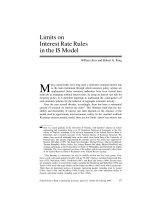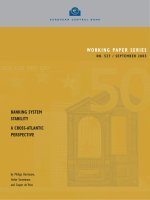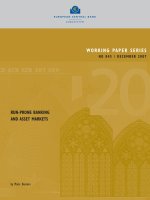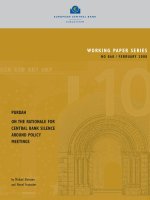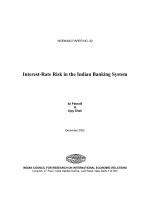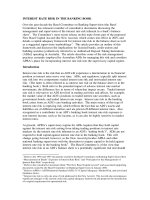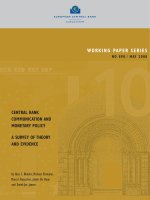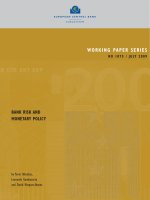WORKING PAPER SERIES NO. 351 / APRIL 2004: INTEREST RATE DETERMINATION IN THE INTERBANK MARKET pot
Bạn đang xem bản rút gọn của tài liệu. Xem và tải ngay bản đầy đủ của tài liệu tại đây (492.54 KB, 50 trang )
W ORKING PAPER SERIES
NO. 351 / APRIL 2004
INTEREST RATE
DETERMINATION
IN THE INTERBANK
MARKET
by Vítor Gaspar
Gabriel Pérez Quirós and
Hugo Rodríguez Mendizábal
In 2004 all
publications
will carry
a motif taken
from the
€100 banknote.
WORKING PAPER SERIES
NO. 351 / APRIL 2004
INTEREST RATE
DETERMINATION
IN THE INTERBANK
MARKET
1
by Vítor Gaspar
2
Gabriel Pérez Quirós
3
and
Hugo Rodríguez Mendizábal
4
1 The views expressed are authors’ own and do not necessarily reflect those of the ECB, the Bank of Spain or the Eurosystem.We thank
the anonymous referee, H-J Klockers, Fernando Restoy, Ulrich Bindseil and seminar participants at the Bank of Spain, ECB, Centra and
University of Alicante for helpful comments and suggestions.We also thank the European Banking Federation for graciously sharing
their data. Rodríguez Mendizábal aknowledges financial support from the Spanish Ministry of Science and Technology through grant
SEC2000-0684 and SEC2003-0036 and from the Barcelona Economics Program of CREA.
2 European Central Bank
3 Banco de España and CEPR
4 Universitat Autònoma de Barcelona and CENTRA
This paper can be downloaded without charge from
or from the Social Science Research Network
electronic library at />© European Central Bank, 2004
Address
Kaiserstrasse 29
60311 Frankfurt am Main, Germany
Postal address
Postfach 16 03 19
60066 Frankfurt am Main, Germany
Telephone
+49 69 1344 0
Internet
Fax
+49 69 1344 6000
Telex
411 144 ecb d
All rights reserved.
Reproduction for educational and non-
commercial purposes is permitted provided
that the source is acknowledged.
The views expressed in this paper do not
necessarily reflect those of the European
Central Bank.
The statement of purpose for the ECB
Working Paper Series is available from the
ECB website, .
ISSN 1561-0810 (print)
ISSN 1725-2806 (online)
3
ECB
Working Paper Series No. 351
CONTENTS
Abstract 4
Non-technical summary 5
1. Introduction 7
2. The theoretical model 11
3. Solution of the model 15
3.1 The last day of the reserve
maintenance period (T) 15
3.2 Days before the last (t < T) 17
4. Simulations 19
5. Description of the data 23
6. Some properties of the data 24
7. Time series and cross section volatility 26
8. Conclusions 29
References 31
Tables and figures 33
European Central Bank working paper series 40
April 2004
Abstract
The purpose of this paper is to study the determinants of equilibrium in the market for daily funds.
We use the EONIA panel database which includes daily information on the lending rates applied by
contributing commercial banks. The data clearly shows an increase in both the time series volatility
and the cross section dispersion of rates towards the end of the reserve maintenance period. These
increases are highly correlated. With respect to quantities, we find that the volume of trade as well
as the use of the standing facilities are also larger at the end of the maintenance period. Our
theoretical model shows how the operational framework of monetary policy causes a reduction in
the elasticity of the supply of funds by banks throughout the reserve maintenance period. This
reduction in the elasticity together with market segmentation and heterogeneity are able to generate
distributions for the interest rates and quantities traded with the same properties as in the data.
4
ECB
Working Paper Series No. 351
JEL Classification: E52, E58
Keywords: Overnight interest rate; Monetary policy instruments; Eonia panel
April 2004
5
ECB
Working Paper Series No. 351
April 2004
NON-TECHNICAL SUMMARY
This paper studies equilibrium in the daily funds market using a model in the tradition
of Poole (1968). The crucial element in this class of models is the assumption that
banks do not know their end-of-day position, with perfect accuracy, at the time they
trade in the money market. The assumption reflects the fact that banks have imperfect
monitoring systems. The model is set-up to incorporate realistic features of the money
market in the euro area. For example it explicitly considers a system of required
reserves with an averaging provision. This feature of the Eurosystem’s operational
framework implies that the elasticity of the net supply of reserves by banks goes down
over the reserve maintenance period. Novel features of the model are the
consideration of heterogeneity across banks and market segmentation. Specifically we
consider the extreme cases of perfect competition and autarchy. We also consider
intermediate cases in which we partition banks into market groups of varying sizes.
This allows for the derivation of distributions for the interest rates across banks and
also for quantities traded.
The model makes use of a number of strong simplifying assumptions. It is a partial
equilibrium model focusing on the money market alone. The dependence of the
excess supply of daily funds from other activities carried out by banks is not modelled
explicitly. Risk neutrality is assumed. The effects of capitalisation within the reserve
maintenance period are ignored. All these simplifying assumptions are unrealistic.
They make it harder for the model to reproduce empirical evidence.
In the paper we make use of the EONIA panel database, kindly made available by the
European Banking Federation (EBF). The database includes daily information on the
lending rates for operations involving contributing banks. The sample includes 64
banks and the period covered goes from 4 January 1999 to 9 November 2002. Interest
rates correspond to actual trades. The data clearly shows an increase in the average
time series volatility and cross section dispersion towards the end of the reserve
maintenance period. These increases are highly correlated. The correlation stays
strong even after controlling for the influence of variables that explain the joint
behaviour of time series volatility and cross-section dispersion. A number of such
variables were identified by Perez-Quiros and Rodriguez-Mendizabal (2003) and
include the beginning and the end of the reserve maintenance period, the dates of
meetings of the ECB’s Governing Council and the end-of-the month. We argue that
6
ECB
Working Paper Series No. 351
April 2004
this finding provides strong support for the theoretical model (with market groups)
since the model predicts that liquidity shocks move volatility and dispersion of
interest rates exactly in line with the pattern found in the data. Moreover quantities
traded and the use of standing facilities also increase at the end of the reserve
maintenance period also in line with the theory.
1. INTRODUCTION
The purpose of this paper is to study the determinants of equilibrium in the market for daily funds.
Understanding the behaviour of the overnight market for unsecured loans is important both from a
policy as well as from a research point of view. The basic reason is that this market hosts the first
step in the monetary transmission mechanism. There is a long literature analysing this mechanism,
that is, the process by which central banks are able to affect their ultimate goals of policy through
changes in policy instruments under this context. However, most of the papers in this literature
simplify matters by assuming central banks have direct control of a short-term interest rate [see, for
example, Taylor (1999) or McCallum (1999)]. Here, we construct a theoretical model of the money
market to explicitly analyse how this control is actually exerted.
There are several issues we address with this model. First, we look at the linkages between the
statistical properties of the equilibrium in the overnight market and the operational framework of
monetary policy. We see this as a necessary step in order to address questions about the effects of
changes in the design of the central banks’ operational framework. Relevant features include
reserve requirements, length of reserve maintenance periods, existence of standing facilities,
maturities and frequency of open market operations, etc. Second, although the model cannot be
estimated directly, we use a set of testable implications to take it to the data. It turns out that the
model is able to reproduce the most salient features that characterise the overnight interest rates in
the euro area.
Most available empirical studies on the high frequency behaviour of overnight interest rates focus
on the US case. References include Campbell (1987), Lasser (1992), Rudebusch (1995), Roberds et
al. (1996), Hamilton (1996), Balduzzi et al. (1997), Furfine (2000) and Bartolini, Bertola and Prati
(2001, 2002). Prati, Bertola and Bartolini (2002) argue that some of the empirical facts identified
for the US are no longer relevant when alternative institutional settings are considered. The case of
a “corridor system” is particularly relevant. In a corridor system overnight market interest rates are
bound by the existence of two standing facilities provided by the central bank, with pre-determined
interest rates. A deposit facility where banks can deposit their excess clearance balances, earning a
given return and a lending facility which provides access to liquidity, at a given interest rate, against
the pledging of eligible collateral. Outside the US the “corridor system” has been adopted by a
series of countries during the last decade, namely Australia, Canada, Denmark, the euro area, New
Zealand, Sweden, and the UK. Since the start of the ECB’s single monetary policy in 1999, a
significant amount of research has been devoted to identifying the relevant empirical facts
7
ECB
Working Paper Series No. 351
April 2004
characterising the euro’s market for overnight funds. Relevant references include Angeloni and
Bisagni (2002), Cassola and Morana (2002), and Würtz (2003). In this paper we pursue this
empirical research programme further by considering lending rates charged by individual banks. To
our knowledge, this is the first paper in the literature to address the determination of rates from this
point of view, particularly focused in the Euro area. Specifically, we use data on individual banks to
study the joint statistical distribution of overnight rates over time and over the cross section of
banks.
In our research we have been able to use the EONIA panel database, kindly made available by the
European Banking Federation (EBF). This database includes daily information on the lending
rates applied by contributing commercial banks. The data clearly shows an increase in both the time
series volatility and the cross section dispersion of rates towards the end of the reserve maintenance
period. These increases are highly correlated. With respect to quantities, we find that the volume of
trade as well as the use of the standing facilities are also larger at the end of the maintenance period.
These facts motivate the modelling strategy in the paper.
Most of the theoretical models of daily funds market equilibrium have evolved from the early
seminal contribution by Poole (1968)
1
. Some of the papers in this literature are Angeloni and Prati
(1996), Bartolini, Bertola and Prati (2001, 2002), Henckel, Ize and Kovanen (1999), Pérez-Quirós
and Rodríguez Mendizábal (2003) and Woodford (2001). All these models share a main ingredient:
the existence of a “liquidity shock” that creates uncertainty in the liquidity management of
commercial banks and that we interpret in terms of imperfect information. Specifically, the idea is
that commercial banks trade in the overnight funds market before they are able to determine their
end-of-day balance with certainty. Furfine (2000) interprets this residual uncertainty as coming
from “operational glitches, bookkeeping mistakes, or payments expected from a counterpart that fail
to arrive before the closing of Fedwire”. In other words, credit institutions have less than perfect
information and monitoring systems.
Usually these models are only concerned with the evolution of prices so they model representative
agent economies. They are pure pricing models. However, in order to be able to explain the joint
distribution of prices and quantities both in the time as well as in the cross section dimension, one
needs to allow for heterogeneity plus some form of market segmentation. In this paper we provide a
model with heterogeneous commercial banks subject to idiosyncratic shocks. These banks interact
1
See also Baltensperger (1980) for a survey and references to the early literature on this subject.
8
ECB
Working Paper Series No. 351
April 2004
with the central bank through payment systems and the operational framework of monetary policy.
The model provides a stylised representation of the relevant institutional features for the euro area.
Commercial banks also interact with each other through the payments mechanism and the daily
funds market. A form of market segmentation will prevent efficient netting, the verification of the
law of one price, and will generate a distribution of interest rates across banks. It delivers testable
propositions on the behaviour of interest rates over time and across banks, use of standing facilities
and amounts traded. These are the propositions we confront with the empirical evidence
2
.
Market segmentation might look as an ad hoc proposition to model money markets, much more
when banks exchange an extremely homogeneous good, reserves. However, talking with money
market dealers of different private banks of the Euro area, it seems a plausible representation of the
reality of money markets. The reasons usually argued by the practitioners not to have a single
market are the existence of credit limits or agents playing a reputation game. According to the
dealers, being short one day by a big amount is a piece of information they do not want to share
with the general market. So, they prefer to pay more to settle their accounts privately with banks
they usually do business with. Therefore, there are subgroups of trading banks that settle with each
other before going to the general market or the standing facilities.
The design of the theoretical model is intended to replicate some of the basic features of the daily
market for funds in the euro area. In doing so we try to account for the most important elements of
the operational framework for monetary policy. Our economy consists of a central bank and n
commercial banks. These banks exchange overnight deposits in segmented markets and are subject
to liquidity shocks. Commercial banks have to maintain a given level of required reserves on
average during a reserve maintenance period. As in the Eurosystem, the central bank offers two
standing facilities: a lending and a deposit facility. The two standing facilities define a corridor
limiting the fluctuation in the overnight rate. We show that such an environment reproduces the
main features of the market for funds in the euro area. In particular, the equilibrium in the model is
characterized by rates whose time series as well as cross section volatilities increase towards the end
of the maintenance period and are highly correlated. Furthermore, banks trade and use the standing
facilities more at the end of the maintenance period.
2
Furfine (1999), as Furfine (2000), uses transaction-level data. He looks at trading patterns and networks and
finds evidence on the existence of relationship banking in the interbank market. Furfine does not explicitly
address the theoretical modelling of bank heterogeneity together with market segmentation.
9
ECB
Working Paper Series No. 351
April 2004
The intuition behind these results is as follows. Every day banks face two risks. On the one hand, an
unforeseen decrease in available funds may make a commercial bank use the lending facility. This
is costly because the lending rate is larger than the market rate. On the other hand, in the opposite
case of an unforeseen increase in available funds, a bank may fulfil reserve requirements early on
during the reserve maintenance period, a case in which we say the bank is being “locked-in”. This is
also costly because the marginal value of reserves accumulated beyond the requirement is the
deposit rate which is smaller than the market rate. Thus, when banks determine how much funds to
supply to the market on every day of the maintenance period, they will look at how their decisions
affect the probability of ending the day with an overdraft as well as the probability of being
“locked-in”. Given an initial amount of reserves, if banks had the same supply of funds on every
day, the probability of having an overdraft would be constant over time. However, the probability of
having excess reserves would get larger as we approach the last days of the maintenance period. To
compensate for this latter effect, banks try to hold relatively fewer reserves on the first days of the
period and relatively more towards the end so as to reduce the probability of satisfying the reserve
requirement early in the period.
The adjournment in the accumulation of reserves by banks have a further implication. As the end of
the maintenance period gets nearer, the ability of banks to offset past shocks decreases. This makes
banks more sensitive to shocks as time passes so that the elasticity of supply becomes a decreasing
function of time. Thus, at the beginning of the period the supply of funds is very elastic. Banks are
basically indifferent between different holdings of reserves, so they do not have the need to
compensate liquidity shocks. They trade little and the interest rates are very similar both across
banks and across time. On the last days of the period, though, supplies are inelastic so that shocks
late in the period will have a larger effect on prices. Introducing market segmentation in this setting
makes the cross section as well as the average across banks become more volatile towards the end
of the reserve maintenance period. Furthermore, trade is also larger on the last days of the period as
banks try to get their desired level of reserves. This larger trade happens both between banks and
with the central bank through the use of the standing facilities.
The paper is structured as follows. In Section 2, we introduce the theoretical model. In Section 3 we
solve the model and present the expressions that determine the demand for funds on each day of the
maintenance period. Because the model cannot be solved explicitly, in Section 4 we perform
numerical simulations in order to illustrate the properties of the model. Section 5 contains a
description of the data set, which includes the daily contributions from individual banks used to
compute the EONIA rate. The properties of the data are examined in Section 6. In Section 7 we
10
ECB
Working Paper Series No. 351
April 2004
model the time-series and cross-section behaviour of interest rates in the daily funds market in a
systematic way. Finally, Section 8 concludes.
2. THE THEORETICAL MODEL
In the model we consider n commercial banks and one monetary authority, the central bank.
Commercial banks maintain deposits, called current accounts, with the central bank in order to fulfil
reserve requirements and payments responsibilities. The operational framework of the central bank
is composed of two elements. The first one refers to certain restrictions on the current accounts hold
by commercial banks. Reserve balances of commercial banks cannot be negative by the end of each
trading session and the accumulated balance over each reserve maintenance period has to be large
enough to meet required reserves, that is, it cannot be smaller than a number R > 0. This number R
corresponds to the level of required reserves and is pre-determined. The reserve maintenance period
has a length of T days. The second element consists of two standing facilities provided by the
central bank. There is a lending facility where banks can borrow funds at the interest rate i
l
and a
deposit facility where banks can deposit funds at the rate i
d
. These facilities are always available to
commercial banks.
The main decision each bank has to make on every day is to determine how much funds to trade on
the money market. In deciding the amounts to borrow or lend in any session, banks take into
account their reserve position. The position of bank j = {1, 2, …, n} is summarised by its current
account with the central bank at the time it reaches the market on day t,
j
t
a , and the amount of
reserves the bank has to accumulate from session t until session T to satisfy its reserve requirement,
also known as its deficiency,
j
t
d
3
. Assume that all banks start day 1 being identical, that is,
RDd
j
t
1
and
1
Aa
j
t
. The pair
j
t
s = (
j
t
j
t
ad , ) defines the individual state of a bank on any
particular session.
In every session, banks are subject to shocks. In the general description of the model we distinguish
between pre-trade shocks (
j
t
H ), that is, shocks that arise early in session t, before bank j exchanges
3
In general, lower case letters refer to individual banks while capital letters refer to per capita market
aggregates.
11
ECB
Working Paper Series No. 351
April 2004
funds in the market, and post-trade shocks (
j
t
O
), which represent late shocks that arise after trade
takes place. We restrict these shocks to be i.i.d. across time. They follow the distributions:
),(~
jjj
t
F
HHH
VPH
and
),(~
jjj
t
F
OOO
VPO ,
where
j
i
P is the mean of the shock i = H, O for bank j and
j
i
V is its standard deviation. Notice
shocks are assumed to follow distributions that may differ across banks and not necessarily
independent among them.
The timing of events between two sessions is as follows: consider a bank, say j, that is about to
enter the market on day t. The bank has a deficiency
j
t
d and an account balance of
j
t
a . Let
j
t
m and
j
t
b be the amount of reserves kept by this bank and the ones loaned out to the market at session t,
respectively. These magnitudes have to satisfy
j
t
j
t
j
t
abm (1)
and
0
t
j
t
m . (2)
After the bank leaves the market, it receives the late shock (
j
t
O ), so the balance at the end of the day
in bank j’s current account is
j
t
j
t
j
t
mr O .
The following day, the bank receives an early morning shock (
j
t 1
H ), so tomorrow’s balance at the
central bank by the time bank j goes again to the market is
j
t
j
t
j
t
j
t
aa
11
HO . (3)
Notice that any reserves exchanged on any day have to be returned the following day. Additionally,
we make the simplifying assumption that interest payments on borrowing and lending are not
capitalised. Reserve deficiencies,
j
t
d , evolve over time as
]},0max[,0max{
1
j
t
j
t
j
t
rdd
, (4)
12
ECB
Working Paper Series No. 351
April 2004
for t < T . That is, the reserve balance of the bank at the end of the session (
j
t
r ) is accumulated only
if it is positive and deficiencies have a lower bound of zero. Because current accounts cannot be
negative overnight, all reserves maintained in the central bank after the accumulated balance of a
bank reaches the reserve requirement R are kept in excess and remunerated at the deposit rate.
Given market rates, the distribution of shocks, the distribution of banks over individual states and
the evolution of those states, banks decide on borrowing and lending in order to maximise the
expected sum of profits over all T sessions
¸
¸
¹
·
¨
¨
©
§
S
¦
T
t
j
t
E
1
1
,
where E
1
is the expectation with respect to the information set at the beginning of trading session 1.
Let
j
t
i be the interest rate at which bank j exchanges reserves in the market at the session t. The
profits of this bank on any day, are
j
t
j
t
j
t
j
t
cbi S , (5)
where
j
t
j
t
bi are the revenues (costs) from lending (borrowing) funds in the market at the rate
j
t
i and
j
t
c represents the end-of-session costs derived from going to the deposit and lending facilities of the
central bank.
The particular expression for the costs of using the facilities,
j
t
c , depends on the day of the
maintenance period. For the last day of the period, these costs are
][)(][)(
j
T
j
T
j
T
j
T
j
T
j
T
dj
T
j
T
j
T
j
T
j
T
j
T
lj
T
mdImdimdImdic OOOtO , (6)
where I[a] is an indicator function that takes value 1 when the statement in brackets is true. If the
balance of the bank at the end of the day (
j
T
j
T
m O ) is not enough to fulfil the deficiency (so that
j
T
j
T
j
T
md Ot ), the bank will have to borrow the difference from the lending facility. Otherwise, if
the bank accumulates excess reserves (
j
T
j
T
j
T
md O ) they will be deposited at the deposit facility
13
ECB
Working Paper Series No. 351
April 2004
earning the rate i
d
. Since in equilibrium the market rate is between i
d
and i
l
, the bank will use the
facilities only if it has to. For the rest of days, t < T, the costs of using the facilities are
][)(]0[)(
j
t
j
t
j
t
j
t
j
t
j
t
dj
t
j
t
j
t
j
t
lj
t
mdIdmimImic OOOtO . (7)
If the balance of the bank at the end of the day is negative (that is,
j
t
j
t
m Ot0 ), the bank will have
to borrow the necessary funds from the lending facilities to set it to zero. Otherwise, if the bank
accumulates excess reserves (
j
t
j
t
j
t
md O ) they will be deposited at the deposit facility earning the
rate i
d
.
In order to generate a distribution of rates, the model will be solved for a variety of economies that
differ upon the trade frictions we impose on market participants. The possibilities range from the
frictionless case to autarchy. In the frictionless case banks meet in a single market place and all
trades are centralised there. The equilibrium outcome of that economy can be characterised by a
single interest rate and a distribution of quantities traded. This distribution depends on the
heterogeneity of banks, that is, the levels of reserves they start the day with (
j
t
a , j = 1,…, n) and the
deficiencies they have (
j
t
d , j = 1,…, n). As we will see below these two variables will determine
the supply of funds for each bank and, therefore, the amounts transacted in the market. In autarchy
there is no trade and a distribution of shadow interest rates is obtained. These shadow prices are
defined as the marginal cost of borrowing or lending the first unit of reserves and, therefore, its
distribution will also depend upon the heterogeneity of banks on each day.
Between these two economies we can generate additional ones in the following manner. Think of an
economy where, because of search or transaction costs, markets are segmented. They are like
islands not connected with one another. Each of these separated markets can in principle generate a
different price and a different amount traded because their composition in terms of the agents
involved may differ from one to another. So, if we look at the economy as a whole, it will be
characterised by a joint distribution of prices and quantities. Next, we can perform the experiment
of increasing the transaction/search costs. When these costs are zero or very small, the optimal size
of the market is the whole economy. This is what we call the frictionless case. As we increase these
costs the size of these markets decrease and the solution converges to the autarchic case.
14
ECB
Working Paper Series No. 351
April 2004
3. SOLUTION OF THE MODEL
The way to solve this problem is by backward induction. We first solve the model at time T and
work backward towards the first period.
3.1 The last day of the reserve maintenance period (T)
The problem of bank j on the last day T can be written in dynamic programming form as follows.
Let );(
T
j
TT
SsV be the value function defined as the maximized profits of bank j at the last day of
the period given its individual state
j
T
s and the aggregate state
T
S . This function satisfies:
)(max)(max);(
j
T
j
T
j
TT
b
j
TT
b
T
j
TT
cbiEESsV
j
T
j
T
S , (8)
with
j
T
c defined in (6). The first order condition for a maximum is
])(1[)(
j
T
j
T
j
T
dj
T
j
T
j
T
lj
T
abdFiabdFii
OO
. (9)
This expression says that banks determine their supply of funds to the market in order to equate the
marginal revenue of lending an additional unit of reserves with the expected marginal cost of that
unit when reserves are needed, that is, when they are computed for the reserve requirement. These
costs are i
l
when the bank is overdrawn [with probability )(
j
T
j
T
j
T
abdF
O
], and i
d
when the bank
has excess reserves [with probability )(1
j
T
j
T
j
T
abdF
O
]. From this expression we observe that
the supply of reserves of bank j,
j
T
b , is increasing with its initial level of reserves (
j
T
a ), the rate at
which the bank exchanges reserves in the market (
j
T
i ), and it is decreasing with the reserve
deficiency (
j
T
d ), the lending rate (i
l
) and the deposit rate (i
d
). Furthermore, the partial derivative of
the value function with respect to
j
T
d is
j
T
j
T
T
j
TT
i
d
SsV
w
w );(
. (10)
Remember from (9) that the supply of reserves on the last day of the maintenance period depends
negatively on the level of deficiency. Therefore, the opportunity cost of starting the last day of the
reserve maintenance period with one more unit of deficiency is equal to the market interest rate lost.
15
ECB
Working Paper Series No. 351
April 2004
Case a: frictionless economy. The particular form of the equilibrium solution depends upon the
market structure considered. First, assume that all trades are centralized in a market place and there
is perfect information about banks situation in terms of the values of
j
T
s and its distribution. In this
case, there is a single interest rate that clears the market,
T
j
T
ii . In the market, loans are in zero net
supply so, aggregating supplies yields the equilibrium rate
4
)()(
TT
dld
T
ADFiiii
O
. (11)
In this expression D
T
and A
T
are the per capita level of deficiency and initial reserves, respectively:
j
T
n
j
T
j
T
n
j
T
a
n
Ad
n
D
¦¦
{{
11
1
;
1
.
Then, the supply of funds by bank j,
j
T
b , becomes
)()(
j
T
j
TTT
j
T
adADb , (12)
so a bank will be supplying or demanding reserves in the market depending on whether the
“individual excess reserves”
j
T
j
T
ad are below or above the aggregate value. Notice a bank can
have excess reserves,
j
T
d <
j
T
a , and still borrow them because the average value is even lower. As
we have seen, in that situation reserves will be cheap.
Case b: autarchy. Now assume that banks are on their own so no trades are possible. Since banks
are isolated,
j
T
b = 0 and the shadow rate is
)()(
j
T
j
T
dldj
T
adFiiii
O
, (13)
so that the cross section distribution of shadow rates is a nonlinear transformation of the cross
section distribution of states (
j
T
j
T
ad ).
16
ECB
Working Paper Series No. 351
April 2004
Case c: Market groups.
In order to generate intermediate cases, where there is a cross section of
both, prices and quantities, assume we form random groups of size h. If h is n we are in the
frictionless market (case a). If h is 1 we have autarchy (case b). We use g(h) to index groups. It
gives the different groups that can be made of h members out of n agents. We assume competition
within each group. Aggregating supplies for each group yields the equilibrium rate
][)(
)()()( hg
T
hg
T
dldhg
T
ADFiiii
O
(14)
with
)(hg
T
D and
)(hg
T
A being the aggregate values of deficiencies and reserves for that group, i.e.
j
T
n
hgj
hg
T
j
T
n
hgj
hg
T
a
h
Ad
h
D
¦¦
{{
)(
)(
)(
)(
1
;
1
(15)
while trade of bank j within the group is
)()(
)()( j
T
j
T
hg
T
hg
T
j
T
adADb . (16)
3.2 Days before the last (t < T)
Define the value function as
>
@
>
@
);(max);(max);(
111111
S
t
j
tt
j
t
j
t
j
tt
b
t
j
tt
j
tt
b
t
j
tt
SsVcbiESsVESsV
j
t
j
t
,
where the costs of using the facilities,
j
t
c , are defined in (7). Using the evolution of
j
t
d
1
in (4), the
first order condition with respect to
j
t
b gives
>
@
OO
)(1)(
j
t
j
t
j
t
dj
t
j
t
lj
t
abdFiabFii
4
See Pérez Quirós and Rodríguez Mendizábal (2003) for details on this expression.
17
ECB
Working Paper Series No. 351
April 2004
j
t
j
t
j
t
j
t
j
t
t
j
tt
abd
ab
dfdf
d
SsV
j
l
j
l
j
l
j
l
j
l
OO
»
»
¼
º
«
«
¬
ª
HH
w
w
OH
f
f
³³
)()(
);(
11
1
111
, (17)
which generates the supply of funds on sessions t < T
5
. Notice, it depends on the marginal value of
reserves on the next session as measured by the partial derivative of the value function but only in
those instances when the bank is accumulating reserves. As before, banks equate the marginal
revenue with the marginal cost of supplying funds. For any t < T, the partial derivative of the value
function with respect to
j
t
d is
>@
w
w
O
)(1
);(
j
t
j
t
j
t
d
t
j
t
t
j
tt
abdFi
d
ssV
j
t
j
t
j
t
j
t
j
t
t
j
tt
ab
dfdf
d
SsV
j
l
j
l
OO
»
»
¼
º
HH
«
«
¬
ª
w
w
OH
f
f
f
³³
)()(
);(
11
1
111
. (18)
The intuition of this expression is as follows. The cost of having a unit of deficiency more on day t,
depends on the situation of the bank at the end of the day. If the bank ends up the day locked-in,
starting day t with a larger deficiency has a low value, the deposit rate. This event happens with
probability [ )(1
j
t
j
t
j
t
abdF
O
]. This is the first term of the right hand side of (18). In all other
cases, a larger deficiency increases
j
t
d permanently and the value of this event is determined by
j
t
j
t
dV
11
/
ww . This is the second term.
In general, explicit expressions for the solution of this model are not available for days t < T. The
next section presents numerical simulations to show the main results. However, some intuition is
available from the form of the expressions that define the solution. From (17) we see that in
determining their supply of funds, banks care about the cases where the reserve problem is at a
corner, that is, when the bank is overdraft (
j
t
j
t
j
t
ab dO ) or “locked-in” (
j
t
j
t
j
t
j
t
abd Od ).
Because being “locked-in” is an absorbing state, the probability of reaching it increases over time
which makes banks postpone the accumulation of reserves. Also, we can see that there will be use
of the standing facilities before day T. This will happen if a bank has a negative current account at
the end of the day (use of lending facility) or is locked-in (use of deposit facility). Finally, the
18
ECB
Working Paper Series No. 351
April 2004
distribution of interest rates and trade will depend upon the distribution of the individual states
j
t
s = (
j
t
j
t
ad , ). This means that changes in policy will, in general, affect the equilibrium
distributions. In particular, level shifts in which the central bank changes the reserve requirement, R,
in the same amount as the initial reserves, A
1
, are not neutral. Changing the initial level of reserves
together with reserve requirements affects the probability of reaching the corner states, and
therefore, should affect the distribution of rates and quantities under any type of market structure.
4. SIMULATIONS
We simulate an economy with a reserve maintenance periods of T = 3 days with n = 12 banks. Each
of these banks are endowed with A
1
= 100 units of reserves. The reserve requirement is R = 300 for
the whole period. This means that, in the aggregate, the system has enough reserves to satisfy the
requirement. The lending rate is i
l
= 5 percent and the deposit rate is i
d
= 3 percent. This leaves a
200 basis point corridor as in the Eurosystem.
Before fully solving the model and to provide some intuition for the results below, we first compute
the supply functions of an individual bank for a given sequence of expected market rates. Figure 1
presents the supply functions of the “average” bank in the frictionless economy. For each day, it is
assumed that the bank has not received any shock on previous days. In order to compute these
functions, we have to provide the expected rate in the market. To keep the functions comparable
between days, we assume that the expected rate is equal to the middle of the band (i
l
+ i
d
)/2. We see
how the elasticities are reduced gradually over time. The shape of these functions suggests that at
the beginning of the maintenance period, banks are indifferent with respect to their reserve level.
This means that they will not try to compensate liquidity shocks and the interest rate will be stable
both over time and across banks. As the end of the period gets nearer, though, demands become
more inelastic so banks have clearer targets with respect to a particular level of reserves. This
implies more trade and more volatility of rates.
To solve for the equilibrium prices and quantities we carry out a Monte Carlo experiment where we
simulate Z = 1000 reserve maintenance periods identical to the one described at the beginning of the
section. With respect to the shocks, we consider late shocks (
j
t
O ) only. Here,
j
t
O represents the
uncertainty about the changes in the current account by the end of the day because of transfers that
5
See Pérez Quirós and Rodríguez Mendizábal (2003) for details on this expression.
19
ECB
Working Paper Series No. 351
April 2004
take place later in the day, clerical errors and the like. To construct these shocks, define as )(k
j
t
O
the random transfer of funds between banks k and j or the errors committed in accounting for a
known transaction between these two banks. This transfer is assumed to be normal with mean 0 and
standard deviation
ı
. If the shock is positive, funds are moved from bank k to bank j and if negative,
bank j moves reserves to bank k. Assume 0)( O j
j
t
. The shock
j
t
O
, is, therefore equal to
¦
O O
n
k
j
t
j
t
k
1
)(
which follows a normal distribution with zero mean and standard deviation
1V V n
j
.
It is easy to verify that these shocks always sum up to 0 across banks, so no reserves enter or leave
the system in the aggregate and have covariances and correlations equal to
22
])([)( V O OO kEE
j
tt
k
t
j
tt
and
1
1
)(
),(
VV
OO
OOU
n
E
kj
k
t
j
tt
k
t
j
tt
,
respectively. In our simulation, the standard deviation of individual transfers is ı = 20 which
implies that banks are subject to shocks which are jointly normal with standard deviation of ı
j
= ı
(n-1)
1/2
= 66.33 and a correlation between shocks of ),(
k
t
i
tt
OOU = -0.09.
The rationale to model shocks in this way is as follows. Even if no reserves enter or leave the
system, there is aggregate uncertainty in this economy. The reason is that, given the finite number
of banks, prices and trade are not going to be independent on how reserves are reshuffled among
them. In this sense, market segmentation will play a crucial role in linking different distributions of
reserves into different prices. We will show that even in this simple case with no shocks that change
the overall supply of reserves, the statistical properties of prices and quantities traded follow the
stylised facts to be found from the data.
20
ECB
Working Paper Series No. 351
April 2004
Tables 1, 2 and 3 report descriptive statistics for the state of the system defined by the initial levels
of reserves )(
j
t
a , average daily deficiencies [ )1/( tTd
j
t
] and trade (
j
t
b
) for sessions 2 and 3,
and for different sizes of the groups h = {2 ,3, 4, 6, 12}. Let )(zd
j
t
be the average daily deficiency
of bank j = {1, , n} in session t = {1, , T} of the simulation z = {1, , Z}. The column labelled
“mean” in Table 2 corresponds to the average deficiency and is computed as
»
»
¼
º
«
«
¬
ª
¦¦
n
j
j
t
z
z
j
t
zd
nZ
dmean
11
)(
11
)(.
The column labelled “V
ts
” is the standard deviation of the average deficiency computed across
simulations, that is,
¦¦
¸
¸
¹
·
¨
¨
©
§
V
Z
z
n
j
j
t
j
t
j
tts
dmeanzd
nZ
d
1
2
1
)()(
11
)(.
Finally, the column labelled “V
cs
” is the average of the cross section standard deviation, that is,
¦¦¦
¸
¸
¹
·
¨
¨
©
§
V
n
j
n
j
j
t
j
t
Z
Z
j
tcs
zd
n
zd
nZ
d
1
2
11
)(
1
)(
11
)(.
Computations for
j
t
a and
j
t
b in Tables 1 and 3 are equivalent.
The initial level of reserves (
j
t
a ) is an exogenous variable. This means that its distribution does not
depend on the market structure as it is shown in Table 1. Because all banks start identical,
deficiencies on t = 2 are also exogenous, though. On t = 3 as market groups get larger, deficiencies
become smaller and less volatile as banks take advantage of trade. We observe that, for a given size
of the group, the volatility of aggregate variables like the equilibrium interest rate or aggregate trade
is larger on the last day. Also, we see that as the size of the group increases, the aggregate
uncertainty decreases. Table 3 shows that banks respond to the larger uncertainty with more trade
(compare columns for t = 2 and t = 3 in Table 3). As the size of the groups increase there is also
more trade, which is why aggregate uncertainty decreases for the economy as a whole.
21
ECB
Working Paper Series No. 351
April 2004
Table 4 reports statistics for the interest rate. First, we compute a measure of the aggregate interest
rate for this economy. For that, we select banks that make positive loans and compute a weighted
average of their rates. The weights are the percentage of the loans over the whole amount transacted
that session
6
. We compute the square of the change between the aggregate interest rate that session
and the value on the previous one. The average of that series shows in the column labelled V
ts
. It
gives an indication of how volatile the aggregate interest rate is in the time series dimension. We
also compute the cross section volatility of rates for banks that make loans in the market. The
average of the corresponding cross section variance is reported in the column V
cs
. It gives an
indication on how disperse rates are. We observe, the aggregate interest rate is more volatile on the
last day, both in the time as well as in the cross section dimension. Furthermore, as groups become
larger, the volatility decreases, since there is more room for trade.
In Table 4 we also show the correlation between both measures of dispersion in the column U(ts,cs).
We report two ways of calculating this correlation. The first one is constructing a time series of
measures of dispersion and look at their correlation. The result is collected in the column t = 2, 3.
The second one is for each session separately. Both measures of dispersion are very positively
correlated as we find in the data.
Tables 5 and 6 present the use of the standing facilities for different days and size of market groups.
Table 5 shows the probability of going to the lending and deposit facilities. For each realisation for
the Monte Carlo simulation, this probability is computed for each bank given the distribution of
shocks and then those probabilities are averaged over banks and simulations. Table 6 includes the
expected use that all banks will make of the facilities, again averaged over all realisations of the
simulation. As mentioned before, on the first day there is no trading so the use of the standing
facilities is exogenous and, therefore, independent of the size of the market groups. We see that the
recourse to the standing facilities is both more likely and larger on the last day of the maintenance
period than on previous days. It is interesting to notice that the use of the lending facility is very
similar for the three days, while the use of the deposit facility peaks on the last day as we observe in
the data. Finally, as market groups become larger, banks find more opportunities to trade among
themselves and go less to the standing facilities.
Out of the theoretical model and the simulation results we can draw a set of conclusions relevant for
the empirical analysis. It is a clear prediction of the model that interest rate volatility increases
towards the end of the maintenance period. The increase in volatility in a time series dimension with
6
This is the way the EONIA is computed.
22
ECB
Working Paper Series No. 351
April 2004
the evolution of the maintenance period is not new in the literature. A large number of papers
analyse this phenomenon. Hamilton (1996), Wurtz (2001) are just two examples for the US and the
European case respectively. However, the cross-section definition of interest rates, that is,
departures from the law of one price, have not been considered in the literature. The omission may
have been due to lack of relevant data. Associated with these larger price volatilities we find a
larger volume of trade, both in the market across banks and with the central bank through the use of
the standing facilities. This larger trade is also concentrated at the end of the reserve maintenance
period.
5. DESCRIPTION OF THE DATA
The data used in this study consists of interest rates obtained by the major European banks
when they lend funds in the overnight market. In particular, each data point represents the average
interest rate charged in that day by each lending bank. The sample covers 64 banks from January 4
th
1999 to November 9th 2002. This data set was provided by the European Banking Federation
(EBF) and is the one used to compute the time series for the EONIA. The number of observations
on a particular day may be smaller than the number of banks, though, simply because some banks
may not be active on that day or because they are borrowing. Furthermore, the number of banks in
the panel is not always the same because the EONIA panel has changed in different occasions to
include or exclude some banks.
Most of the papers analysing the market microstructure (see Hartmann, Manzanares and
Manna (2000) as an example) usually construct their databases from quotes of the brokers in
Reuters. This has several problems. First, they only cover the part of the market that is traded
through brokers, missing the larger transactions that are usually done directly between banks.
Additionally, brokers, when the market is very active, do not necessarily report the quotes to
Reuters. Therefore, another big part of the market is missing. Finally, the quotes do not oblige the
counterparts to trade, much more when the overnight market is uncollaterized, which implies that
different rates are charged to different banks because of the different risks associated with particular
transactions. On the contrary, in the EBA database the observations correspond to actual trades.
Obviously there are some drawbacks to the EBA database. First, we only have information for
average rates during the day. That characteristic makes it not possible to say anything about the
23
ECB
Working Paper Series No. 351
April 2004
intra-day activity. Second, we have only information about the lenders, not the borrowers. We
cannot test any implication that theory could tell us about the borrowers’ behaviour.
6. SOME PROPERTIES OF THE DATA
In order to empirically test the properties predicted by the theoretical model, some assumptions of
the model could also be analysed to discard some alternative explanations that could imply the same
predicated properties. For example, the model is based on the fact that no bank dominates the
market. Banks are equal at the beginning of the maintenance period and they differ from each other
in the path of the shocks that they receive over the maintenance period. If this is the case, individual
excess profits, calculated as the interest rate obtained by the lending of their reserves minus the
average rate obtained for those reserves, should be uncorrelated across maintenance periods. We
test this hypothesis and we accept it at 5 percent in all but two of the banks of the sample. However,
the models allows (and actually predicts) that profits for a given bank, maybe correlated over time,
within a reserve maintenance period. We test this hypothesis and we reject the null of no correlation
in more than 20 percent of the banks. We conclude from these findings that even though banks play
different roles in different maintenance periods, idiosyncratic shocks allow them to keep advantage
positions within the reserve maintenance period.
Another property that deserves some checking in relation to the structure of the banking system is to
analyse if there exists a relation in the excess profits in a given maintenance period between the
profits obtained by “market power” (i.e. on a given day, how much a bank makes for its reserves in
excess of the market rate) and the “timing” (i.e. on a given maintenance period, how much a bank
makes because it lends when the rates are higher than the average rate of the period). If the
assumptions of the model are correct, these two sources of excess profits should be uncorrelated,
because no bank should have a strategic behaviour in playing the markets game. These assumptions
are corroborated by the data. No bank seems to be systematically playing the game of waiting until
the rates are high to get advantage of its market power and the correlation between these two
sources of excess profits is even negative (-0.13).
An important implication of the theoretical model is that most of the variability appears only in the
last days of the maintenance periods. Our model only has three periods. Is this an appropriate
representation of a 1-month long maintenance period? If three periods are enough, there should not
be any differences in the density function of the data in the first T-2 periods of the maintenance
24
ECB
Working Paper Series No. 351
April 2004
